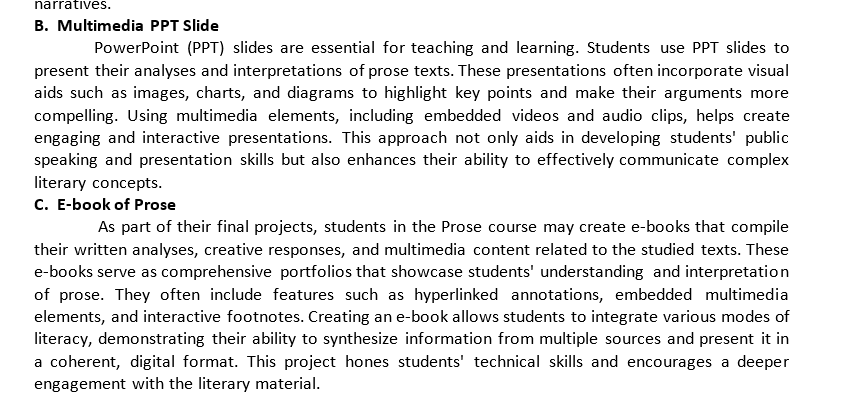Investigating Students’ Multimodal Literacy on Prose in Language Education Course at Billfath University
DOI:
https://doi.org/10.30736/ej.v11i2.1129Keywords:
Multimodal, Literacy, ProseAbstract
This research aims to investigate multimodal literacy on Prose in Language Education course at Billfath University, focusing on how students understand and create meaning through text, images, sound, and digital media. Using qualitative methods, data from 20 sixth-semester students (academic year 2023/2024) were collected through observations, interviews, surveys, and document analysis. Findings indicate the integration of multimodal literacy in activities such as creative writing and digital application use. Students effectively applied multimodal literacy in tasks such as text analysis and digital presentations, despite challenges like limited technology access and technical skills. The research recommends continuous integration of multimodal literacy into the English language curriculum to enhance students' language skills.
Downloads
References
Adami, E. (2016). Introducing Multimodality. In O. The Oxford Handbook of Language and Society. Oxford University Press.
Altas, B. (2014). A Case Study of Multimodal Presentation of Selected Stage Play in A Multimedia Environment. Procedia Social and Behavioral sciences,https://doi.org/10.1016/j.sbspro.014.01.463
Bao, X. (017). Application of Multimodality to Teaching Reading English Language and Literature Studies. https://doi.org/10.5539/ells.v7n3p78
Baxter, P., & Jack, S. (008). Qualitative Case Study Methodology: Study Design and Implementation for Novice Researchers. The Qualitative Report, 13(4), 544-559. https://doi.org/10.46743/160-3715/
Bulut, B., Ulu, H., & Kan, A. (015). Multimodal Literacy Scale: A Study of Validity and Reliability. Eurasian Journal of Educational Research(61). 45-60. https://doi.org/10.14689/ejer.015.61.3
Creswell, I. W., & Creswell, J. D. (018). Research Design: Qualitative, Quantitative, and Mixed Methods Approaches (Fifth ed.). SAGE Publications.
Cook, M. P., & Kirchoff, J. S. J. (017). Teaching Multimodal Literacy Through Reading and Writing Graphic Novels. Language and Literacy, 19(4), 76- 95.
Dewi, K. S., Padmadewi, N. N., & Sudantari, N. M. N. (019). The Use Of Verbal And Non-Verbal Communication By Front Office Staff To Guest At Double-Six Luxury Hotel Seminyak. Jurnal Pendidikan Bahasa Inggris Undiksha, 7(), 4-51.
Eksi, G., & Yakisik, B. Y. (015). An Investigation of Prospective English Language Teachers' Multimodal Literacy. Procedia Social and Behavioral Science, 464-47.https://doi.org/10.1016/j.sbspro.015.07.533
Eryansyah, Erlina, Fiftinova, & Nurweni, A. (019). EFL Students' needs of Digital Literacy to Meet the Demands of 1" Century Skills. Indonesian Research Journal in Education, 44-460
Farías, M., Obilinovic, K., & orrego, R. (2007). Implications of Multimodal Learning Models for Foreign Language Teaching and Learning. Colombian Applied Linguistics Journal, 174-199.
Fedorenko, S. V. (019). Experience of developing students' multimodal literacy in the digital learning environment of higher education institutions.ITLT. 69(1). 1-0. doi: https://doi.org/10.33407/itlt.v6911.405
Gagich, M. (00). An Introduction to and Strategies for Multimodal Composing.
In D. Driscoll, M. Stewart, & M. Vetter (Eds.), Writing Spaces: Readings on Writing (Vol. 3, pp. 65-85). Parlor Press.
Hassett, D. D., & Curwood, J. S. (009). Theories and Practices of Multimodal Education: The Instructional Dynamics of Picture Books and Primary classrooms The Reading Teacher.70-8 https://doi.org/10.1598/RT.63.4.
Heale, R., & Twycross, A. (018). What Is A Case Study? Evidence-Based Nursing. 1(1). https://doi.org/10.1136/eb-017-10845
Hayati, R., Anggraini, H. W., & Jaya, H. P. ICT and Learning Attitude towards Students Academic Paragraph Writing in College Level. ENGLISH FRANCA Academic Journal of English Language and Education, 149-166. https://doi.org/10.940/ef.v511.059
Jakobsen, I. K., & Tønnessen, E. S. (018). A Design-Oriented Analysis of Multimodality in English as a Foreign Language. Designs for Learning, 10(1), 40-5. https://doi.org/10.16993/dfl.89
Kress, G. (010). Multimodality: A Social Semiotic Approach to Contemporary Communication.
Kristina, D. (019). Maximizing multimodal literacies for listening and pronunciation purposes using youtube resources. LINGUA: Jurnal Bahasa dan Sastra 97-101.
doi: https://ejournal.unsri.ac.id/index.php/lingua/article/view/1108
Mills, K. A., & Unsworth, L. (017). Multimodal Literacy. Oxford Research Encyclopedias:MultimodalLiteracy https://doi.org/10.1093/acrefore/978019064093.013.3
Ryu, J., & Boggs, G. (016). Teachers' Perceptions about Teaching Multimodal Composition: The Case Study of Korean English Teachers at Secondary Schools. English Language Teaching, 9(6), 5-60.https://doi.org/10.5539/elt.v9n6p5
Moro, L., Mortimer, E. F., & Tiberghien, A. (019). The Use of Social Semiotics Multimodality and Joint Action Theory to Describe Teaching Practices: Two Cases Studies with Experienced Teachers. Classroom Discourse, 11(3), 9-51. https://doi.org/10.1080/19463014.019.157058
Surkamp, C. (014). Non-Verbal Communication: Why We Need It in Foreign Language Teaching and How We Can Foster It with Drama Activities. 1-7.
Salsabila, Ismarania, F. G., & Mubaroka, W. (01). Information and Communication Technology Learning With Blended Learning. Journal of Information Technology, Informatics and Communication Technology (JITICT), 1(1), 1-5.
O'Brien, L. M., Salinas, A., Reinhart, K. C., & Paratore, J. R. (018). Pre-service Teachers Use of Multimodal Text Sets and Technology in Teaching Reading: Lessons Learned from A Design-Based Study. Literacy Research, Practice and Evaluation, 9, 13-136. https://doi.org/10.1108/S048- 04580180000009009
Pramono, S. A., & Suherdi, D. (019). Exploring EFL Pre-service Teachers' Multimodal Literacy: Level and Implementations. Proceedings of The 019 4th International Conference on Information and Education Innovations, 87-90. https://doi.org/10.1145/3345094.3345103
Pilgrim, J., & Martinez, E. E. (013). Defining in the 1st Century: A Guide to Terminology and Skills. Texas Journal of Literacy Education, 1(1), 60-69.
Tungka, N. F. (018). Guided Literacy Instruction: Helping Students Read Multimodal English-Medium Texts. Indonesian Journal of Applied Linguistics, 8(), 345-357. https://doi.org/10.17509/ijal v81.1381
Wahyuni, A. (018). The Power of Verbal and Nonverbbal Communication in Learning. Advances in Social Science, Education and Humanities Research (ASSEHR), 15, 80-83.
Weller, S. C., Vickers, B., Bernard, H. R., Blackburn, A. M., & Johnson, S. B. C. C. G. J. C. (018). Open-ended Interview Questions and Saturation. PLOS ONE, 13(6). 1-18. https://doi.org/10.1371/journal.pone.0198606
Zhang. M. (015). Teaching Translation with A Model of Multimodality. Asia Pacific Translation and Intercultural Studies, (1), 30-45. https://doi.org/10.1080/3306343.015.1014081

Downloads
Published
How to Cite
Issue
Section
License
Copyright (c) 2024 Anita Rahmah, Eka Fitriyana

This work is licensed under a Creative Commons Attribution 4.0 International License.








